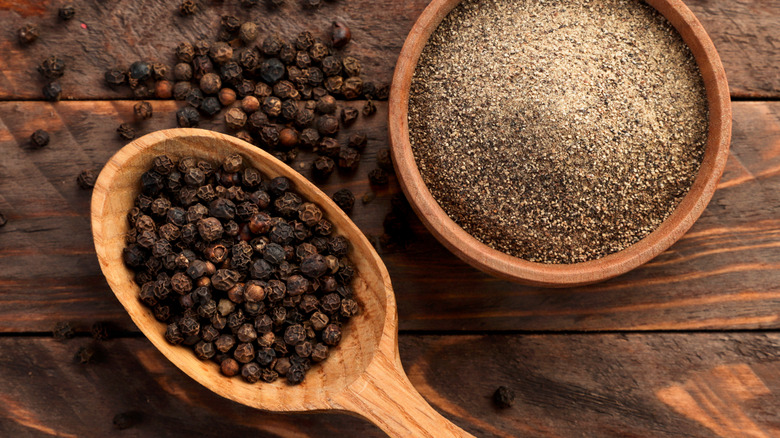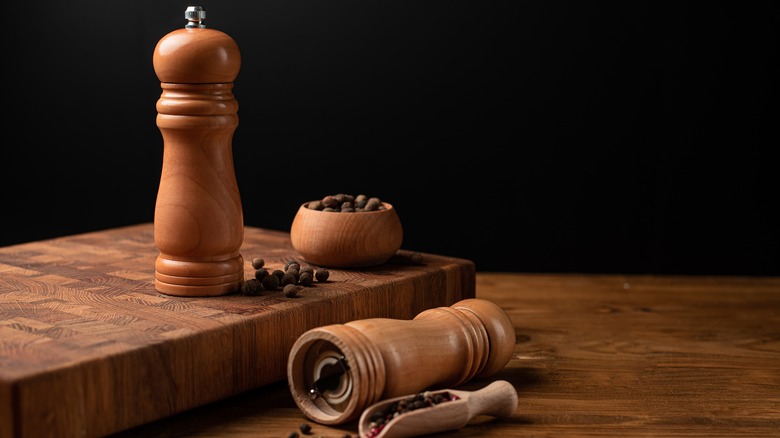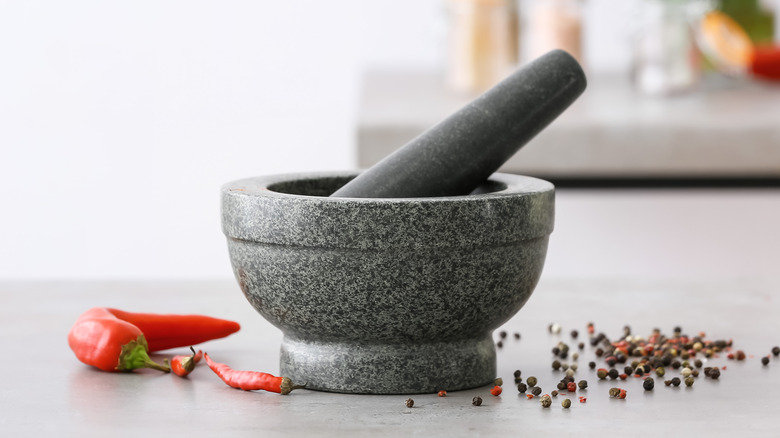The Absolute Best Way To Grind Fresh Pepper
Pepper is the world's most popular spice and it features in almost every culture's cuisine, from adding white pepper to Chinese egg rolls to that final twist of black pepper on a steak. Grinding — or milling — peppercorns to turn them into fresh ground pepper releases the essential oils trapped within each peppercorn, giving pepper its pungent aroma and flavor. Once ground, the aroma and flavor begin to fade, which is why many recipes call for freshly ground pepper.
So what's the best way to grind pepper for your everyday uses? Turn to a pepper mill, also called a pepper grinder, for your go-to tool. Since preparations like soups and sauces usually call for finely ground pepper, while a steak or salad may benefit more from coarse grind, you'll want a peppermill with a precise, adjustable dial, so you can easily switch up the coarseness to suit your needs. A pepper mill is one of those essential tools you can keep right on the kitchen counter to easily grab whenever you need it.
Use a peppermill for perfectly ground fresh pepper
The pepper mill is widely believed to have been invented by the Peugeot brothers (of automotive fame) in 1874. It's essentially just an ingredient-specific type of spice mill. Most spice mills can be used to finely grind various whole spices, including whole peppercorns. Whether you choose to grind with a spice mill or a pepper-specific mill, there are a few details to look for when choosing a mill for grinding pepper. Any peppermill needs to be loaded with peppercorns, which can be a surprisingly chaotic activity. The best peppermills unscrew to reveal a wide opening at the top or bottom for easy, mess-free reloading.
Most peppermills are operated by a twisting action, whereas others have a hand crank. Avoid the hand crank where possible, as this can cause the mill to rotate as you grind, making it hard to target your ground pepper accurately. If you have the budget, an electric peppermill can grind quickly and with zero effort, but it can be pretty frustrating if it runs out of power mid-grind. For many cooks, you can't beat a Peugeot pepper mill, and they're considered the gold standard. Peugeot is so confident in their mills that their hand crank mills come with a lifetime warantee!
More ways to grind pepper
Before pepper mills, ground pepper was mostly made using a pestle and mortar, a tool that's still used in many kitchens today. These crush peppercorns using pressure and friction, releasing more essential oils than the cut-and-grind of a peppermill. A larger, weighty pestle and mortar lets you grind many peppercorns at once — something that would take forever with a peppermill! They're also more versatile than a peppermill, you can make peanut butter with a mortar and pestle, as well as your own spice blends. However, they have some clear downsides: Large mortars are heavy and take up space, while smaller ones take some strength to use effectively.
There are also DIY methods for grinding pepper, which work best for making cracked, coarsely ground pepper. This is well-suited for seasoning steak, or for use in meat marinades, as in this beer-marinated pork rack recipe. Placing whole peppercorns in a large saucepan (not non-stick) and crushing them with the base of another pan works but can get messy, as peppercorns tend to jump around when crushed. The tidiest DIY approach involves placing peppercorns in a plastic bag and using a rolling pin or saucepan to crush them. Alternatively, a burr (as opposed to a blade) coffee grinder creates fantastic finely ground pepper — just make sure to clean it thoroughly before and after to avoid peppery coffee — or coffee-flavored pepper!


